Summer Steelhead: Fishing The West Coast And Great Lakes
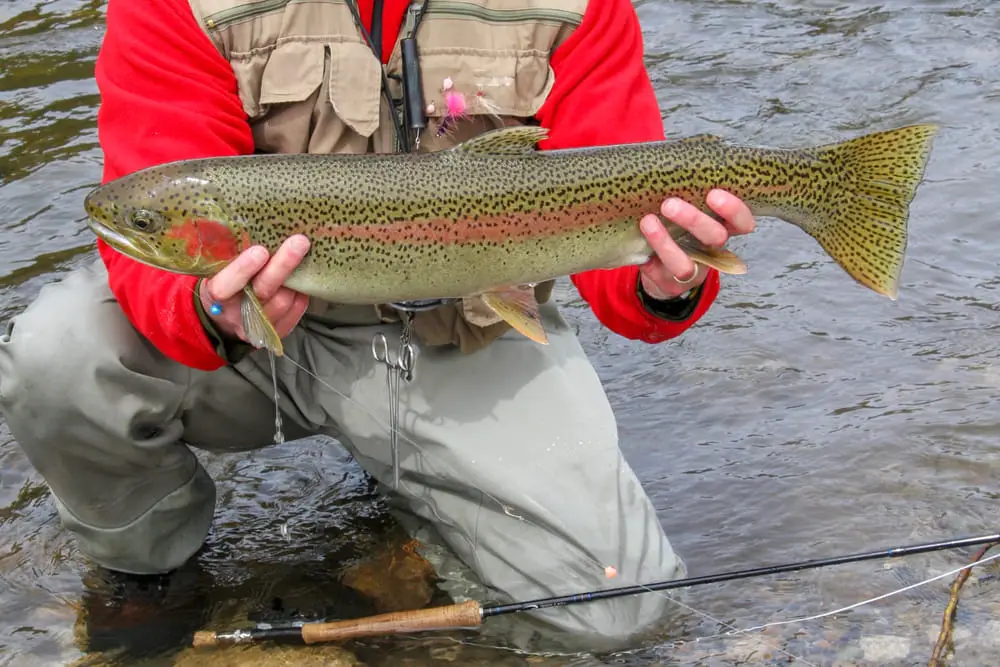
What is a Summer Steelhead?
A summer steelhead is a steelhead that enters the river in the summer, sometimes as early as June or July, and will hold or continue to migrate up to the headwaters sometimes for a few months before they actually spawn. They tend to be smaller due to entering freshwater as less sexually mature than winter steelhead.
Key Takeaways
- About Summer Steelhead: Learn what makes them different, their run times and spawn times.
- Best Areas and Best Rivers: We discuss the prime areas where summer steelhead are found in the world, and in the river, as well as the best rivers to fish for them.
- Fishing Methods: Learn the key fishing methods that guides and veteran anglers use to catch summer steelhead.
- Best Baits and Lures: get information on the hottest baits, different baits for different times of the years, and tips on the most effective lures.
How Are Summer Steelhead Different Than Winter Steelhead?
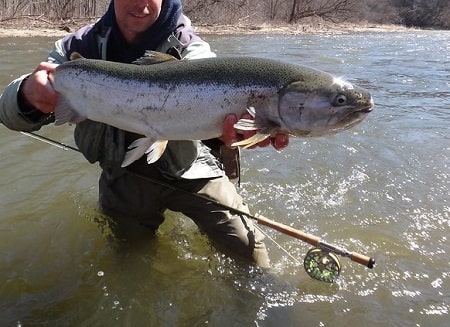
Genetically, summer-run steelhead are nearly identical to winter run steelhead, but a recent study at UC Davis found subtle differences in a gene between the two varieties.
Although the summer and winter steelhead are the same species, this gene variation triggers summer run steelhead to run early for some reason.
Genetically, that’s it! That’s the only difference.
In appearance, summer running steelhead are generally smaller than the winter variety. Some will also say these steelhead are warier of approaching anglers as well, but this may be due to clearer and lower river levels, which might put them on high alert.
There is a specific strain of steelhead known as the Skamania Steelhead, which was developed by the State of Washington from wild stocks on the Washougal River. See Skamania Steelhead.
When Do Summer-Run Steelhead Enter the Rivers?
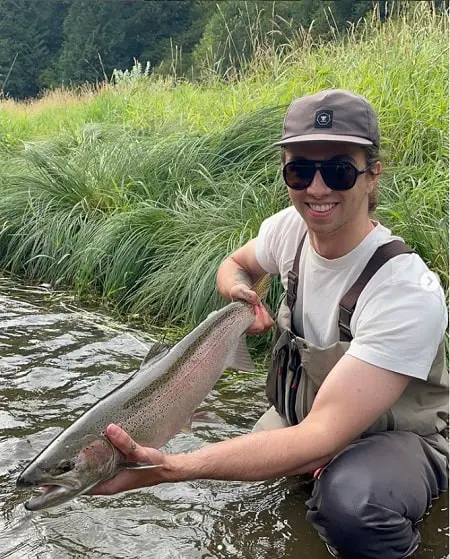
The longer steelhead need to run to where they were hatched, the earlier they will need to start their run.
The first Summer-Run Steelhead will enter as early as May or June on the Pacific Coast and on some Great Lakes rivers. Many more will continue entering the rivers throughout the summer into November before the winter steelhead run begins.
What Triggers the Runs, or Why Do They Run in the Summer?
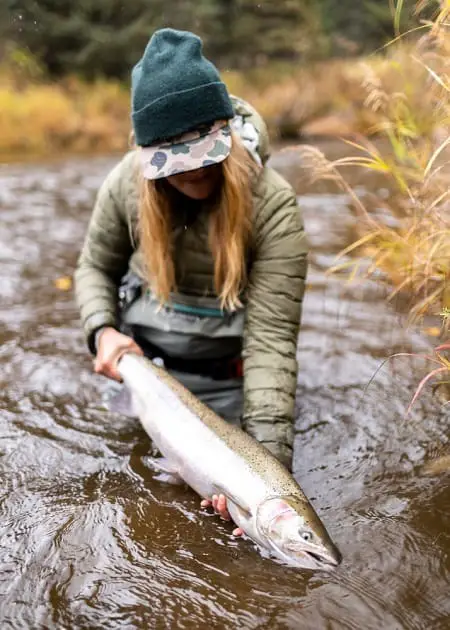
Some say that distance seems to be the overriding reason they run in the summer and is possibly why their genes changed slightly.
Another trigger is rain or increased water levels and stream flows. Increased water levels aid in migration.
Some also believe these summer-run steelheads will enter the rivers to gorge on Chinook salmon eggs. Of course, there are all kinds of theories as to why they run in the summers, but nobody really knows for sure.
When Do Summer-Run Steelhead Actually Spawn?
Although summer strain steelhead starts their migration in the summer, They will spawn from December to March, with the majority spawning in February and March with the warming river temperatures.
The spawn varies with each state, and the distance from the ocean, and the weather can also be a factor as well. Steelhead spawn when the temperature begins to rise in early spring.
A water temperature of 38 degrees is ideal.
Where Can You Catch Summer Steelhead?
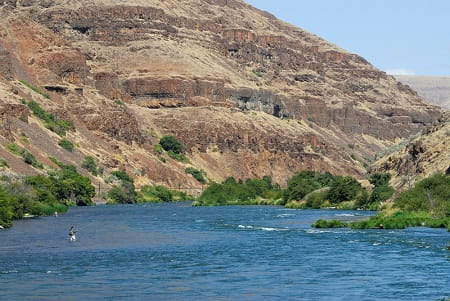
California is as far south as the steelhead range goes.
The rivers from Northern California to British Columbia on the Pacific Coast will have steelhead populations.
Northern California Summer Steelhead is good in August through to November.
As far east as Idaho, you’ll find good steelhead populations.
Pacific West Coast USA: The Columbia Basin drainage in the Northwest is an ideal river system for fishing summer steelhead, with some steelhead running as far as Idaho and Western Montana.
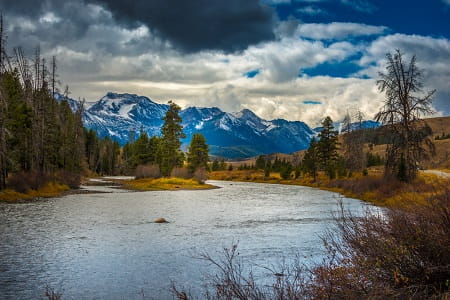
Summer run steelhead will migrate as far up as the Snake River, which has one of the largest summer steelhead runs in the Columbia River System.
Great Lakes Region: Summer run steelhead were stocked in many states and in Ontario, Canada around the 80s and 90’s, with some stocking of Skamania still happening.
New York and Michigan have the best summer run steelhead known as Skamania, which enter the Great Lakes tributaries in the summer months as early as June. See Summer Steelhead Fishing Michigan.
British Columbia: British Columbia has some great steelhead rivers that get large annual runs of summer steelhead. River systems like the Skeena and its tributaries are hot spots for fishing steelhead in the summer.
I will discuss the best steelhead rivers, what the guides say, and more about each area below.
What Are The Best Rivers For Fishing For Steelhead In The Summer?
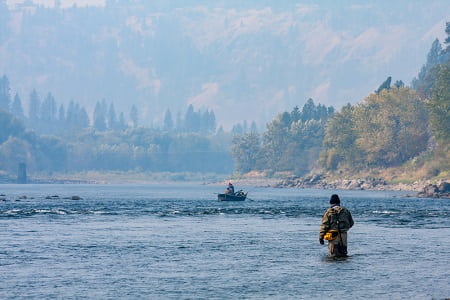
California and Idaho get good runs of steelhead. The Salmon River, Clearwater River, and Snake Rivers in Idaho have a lot of adult returns of summer strain steelhead.
The Snake River is 1078 miles long and is the largest tributary of the Columbia River. It has good tributaries like the Grand Ronde River that also harbor summer and winter-run steelhead.
These rivers are usually good from late August to November for Summer run steelhead or what is known as B-Run Steelhead. See Steelhead Fishing Idaho: A Complete Guide for more on this area.
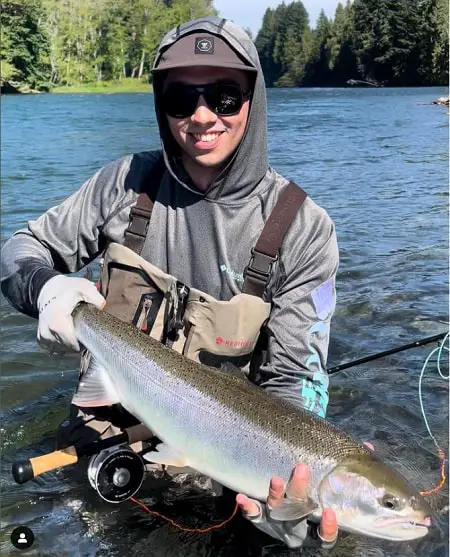
In Oregon, summer run steelhead start showing up into rivers like the Willamette River, Sandy River, Snake River, Deschutes River, and Umpqua River in the summer months.
In California, Humboldt County to Mendocino County, the Eel River, Mad River, Elk River, Redwood Creek, Mattole River, and Klamath River are favorite areas for summer run steelhead.
See California Steelhead Fishing Guide for more on this area.
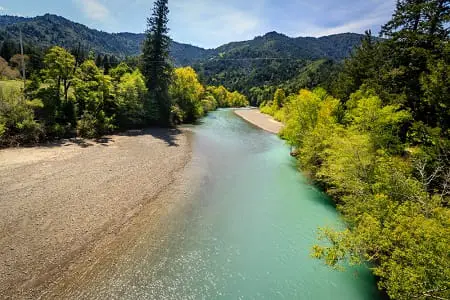
Washington also gets decent summer running steelhead. This fishery is worth looking into, with plenty of river options for anglers.
There are dozens of tributaries feeding the Columbia River Basin bordering Washington and Oregon.
See Steelhead Fishing In Washington and Oregon Steelhead Fishing Guide.
The Siletz River, the Nestucca River, and the Wilson River are all good options for summer-run steelhead.
The Columbia River
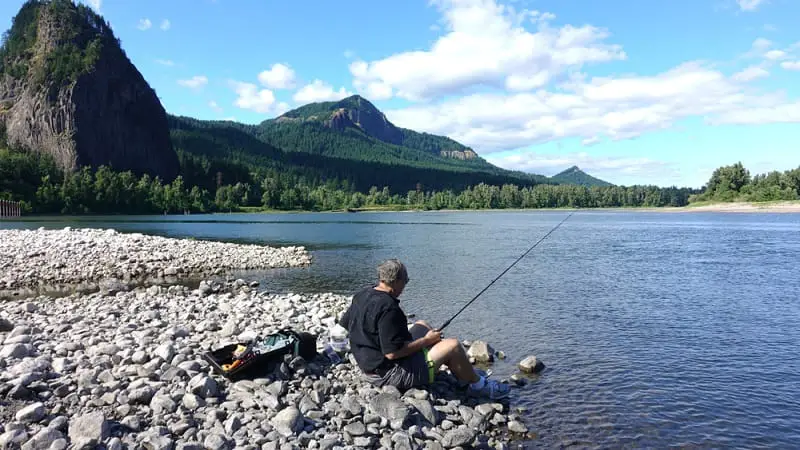
Deschutes Rivers Summer-Run Steelhead – Oregon
The Famous Deschutes River is a Major tributary of the Columbia River flowing through central Oregon. There is a good run of wild and hatchery summer fish on the Deschutes River.
The Deschutes River is known as being primarily a summer-run fishery with steelhead showing up in June, peaking in August and September, and can fish well as late as December in the area or Warm Springs and Trout Creek.
John Day River – Oregon
The John Day River is a large 284-mile tributary of the Columbia River.
A late run of summer fish can be found on the John Day River from September to February. The run is primarily wild fish, which you must release, but there is some hatchery steelhead mixed in.
Local guides say this river gets some of the best summer runs in the state and has lower fishing pressure than other more popular rivers. Peak fishing is in November, but depending on the year, there can be good fishing a couple of months before and after.
Sandy River – Oregon
Sandy River is a 56-mile-long tributary of the Columbia River located in northwest Oregon.
Local guides recommend summer steelie fishing on Sandy River from May Through August. There is also winter-run steelhead fishing from December to April.
Fishing access is plentiful, with plenty of access on the upper river near Cedar Creek Hatchery to the mouth of the Salmon River, and also throughout the river around the parks: Clark Park, Oxbow Park, Dabney Park, and Dodge Park.
Hood River – Oregon
The Hood River is a 25-mile long tributary of the Columbia River, and it gets both summer-run steelhead and winter-run steelhead. This provides anglers with a good year-round steelhead fishery. Local guides say the summer run steelhead fishing is best between September and November.
As the summer steelie fishing winds down, the winter steelhead gets good from December to April.
Access is decent in the mid-river area and upriver near West Fork below Punchbowl Falls.
Willamette River: Oregon
A tributary of the Columbia River, the Willamette River gets both summer and winter-run steelhead making this a good year-round steelhead fishery.
There are good numbers of steelhead in the river from November to March with December to February being peak steelhead fishing. By April through June, fewer summer-run steelhead are left in the river.
The middle fork of the Willamette River also has good summer fishing for steelhead which starts around late May and will continue into November. Winter steelhead fishing in this area is from December to May.
The Mid Fork of the Willamette River offers some excellent fishing for steelhead in the summer, starting in May and running all the way through November. There are also winter steelhead fishing opportunities from December to May.
McKenzie River: Oregon
The McKenzie River is a 90-mile tributary to the Willamette River and has good summer-run steelhead fishing. Summer run steelhead can be caught between the Leaburg Dam to the mouth of the river. The best access and best fishing takes place from May to November and from Hendricks Bridge to Leaburg.
Clackamas River: Oregon
The Clackamas River is an 83-mile tributary to the Willamette River, and it gets decent runs of summer run steelhead and strong runs of winter steelhead due to one of the best stocking programs in the state.
Summer run steelhead could be caught in the river at any time of the year, but most will be from May, June, and through to November.
Local guides say the best summer fishing for steelhead in the Clackamas River is May and June as they are making their way into the river.
Santiam River: South Fork – Oregon
Another summer run steelhead fishery is on the South Fork of the Santiam River, which is a 12-mile tributary of the Willamette River in Oregon. You will find steelhead in this river from April through early October, with peak summer fishing from May to July. Summer run steelhead fishing can remain good into October.
Umpqua River: Both Forks – Oregon
There is good summer run steelhead fishing on the North Fork of the Umpqua River from May until November. You may find some strays on the South Fork. However, the South Fork is primarily a winter-run steelhead fishery from December to April.
The Umpqua is a major west coast river running about 111 miles long
Grande Ronde River
The Grand Ronde River is 182 miles long and is a tributary of the Snake River running through Northwest Oregon.
There are very good runs of summer steelhead, which show up in September. Peak fishing is in October and November and is best in the lower sections near the Washington State line. Some fish will stay in the river until early spring.
Most of the fish in the upper sections of the Grande Ronde River are wild steelhead, but the lower river will have a mix of wild and hatchery steelhead.
Wallowa River – Oregon
The Wallowa River is a 55-mile-long tributary of the Grande Ronde River.
Most hatchery summer strain steelhead that enter the Grande Ronde River will run up the Wallowa River. This is your best bet if you want to keep a steelhead.
British Columbia’s Best Summer Rivers
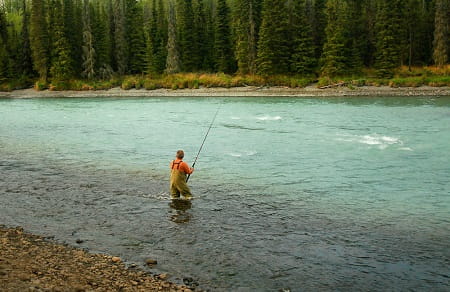
British Columbia rivers also get summer-run steelhead, and local guides recommend the Skeena and Bulkley Rivers.
These BC rivers will start seeing summertime steelhead runs starting in July and peaking from August to October.
There are plenty of tributaries to the Skeena River System that see summer steelhead as early as July, with peak time from mid-August to late October.
The best rivers for fishing steelhead in the summer are:
Bulkley River: A major tributary to the Skeena River with a large run of big summer and winter steelhead. A favorite for many anglers.
Kispiox River: A Tributary to the Skeena River that gets summer runs of steelhead
Copper River: Another Tributary of the Skeena River with a large run of summer strain steelhead that averages 7 to 9 pounds.
Dean River: The Dean River is said to be one of the best summer steelhead rivers on the West Coast.
Babine River: This is a tributary to the Upper Skeena River that get good numbers of summer run steelhead.
For more details information, check out Steelhead Fishing British Columbia.
Great Lakes Summer Run Steelhead Rivers.
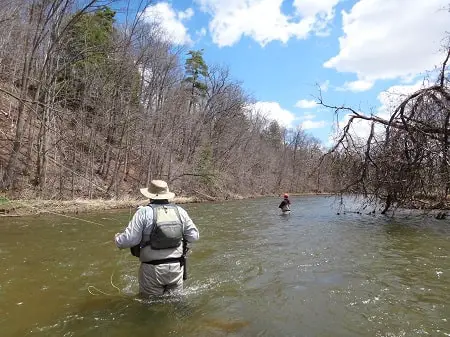
You can find summer steelhead in Michigan and New York state, with good populations and with a few very large fish.
Primary rivers in the Great Lakes include the Salmon River in New York, which gets stocked with a summer run strain of steelhead known as a Skamania Steelhead.
The St. Joseph River, The Manistee River, Rogue River, and The Pierre Marquette River flowing into Lake Michigan offer anglers good fishing for steelhead in the summer starting in June through until February.
The Nottawasaga River in Ontario, Canada gets steelhead entering the river in late August and September, and they peak in October and November.
For guide trips on this river check out A Perfect Drift Guide Company or Smooth River Guide Co.
Keeping Summer-Run Steelhead
Many rivers will have both hatchery and wild summer run steelhead, but some states like Oregon do not allow you to keep wild summer run steelhead, and only hatchery fish may be kept in some rivers, so be sure to double check the local fishing regulations to be sure you know the laws.
Summertime Steelhead Fishing
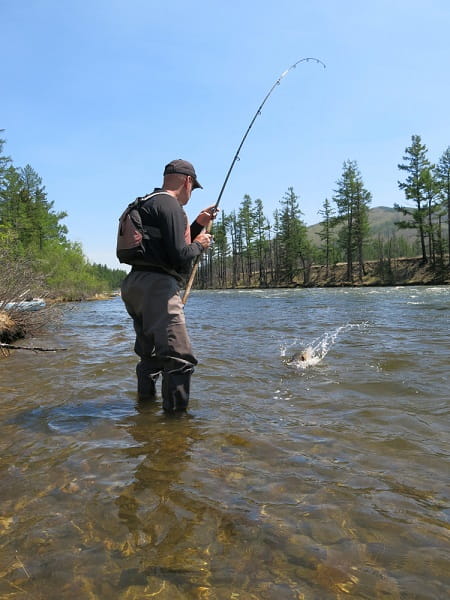
One advantage to summer run steelhead is there is often less angling pressure.
Most traditional steelhead methods and setups will work. The same fly patterns will also work. Proper presentations will help you land more summer steelhead,
In the west, during early summer, many rivers run higher with the runoff as the snow melts at higher elevations and this run-off can cool the river water, and the river can change from clear to translucent green, but that’s not a bad thing for summer steelheaders.
In the Great Lakes area, the summer steelhead season will start with bigger rains in July and August that raise river levels, and this will get some summer steelies moving in as early as June on the bigger colder rivers.
Best Methods For Catching Steelhead In The Summer
- Lure Fishing – Lures like spinners and spoons are always good options for summer run steelhead.
- Drift Fishing
- Plunking
- Bobber Doggin: A relatively new method for steelhead and salmon
- Bottom Bouncing: Very effective in pocket water, rapids, and shallower sections.
- Float Fishing
- Jig Fishing
- Back Trolling
- Back Bouncing
- Fly Fishing
See all the best fishing methods on my page Fishing For Steelhead.
Float Fishing
Float fishing is a method of suspending your bait and keeping your bait at the right level for steelhead and in their strike zone.
Floats can be adjusted to rest at any level in a river, and a shorter, clear leader on the downside of the float will present your bait at the level you want.
Float fishing can be done with spinning gear, and baitcasting reels, or the most effective way is to use a Centerpin reel. See Centerpin Fishing and Float Fishing: Best Methods And Tactics.
Fly Fishing
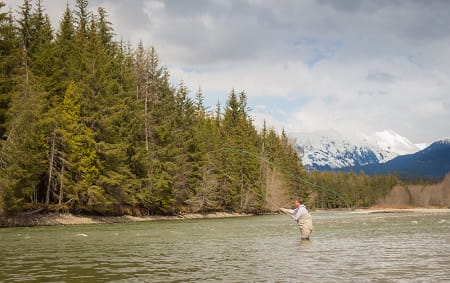
Most anglers will use subsurface methods such as nymphing, or streamer fishing for summer steelhead but it’s not uncommon to catch large adult steelhead on dry flies. Anglers will travel across the world for an opportunity to catch steelhead on the surface.
Spey fishing and swinging flies are commonplace on many of the larger rivers in the west and around the Great Lakes region. “Spey” rods, are two-handed fly rods from 10’6” to 14’ in length and large Spey flies are best.
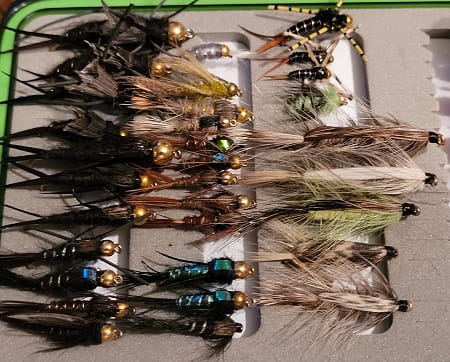
Steelhead will develop the tendency to feed on aquatic insects especially in the summer when eggs are less abundant. Therefore nymphing is another technique that fly fishermen use with good success.
See Fly Fishing For Steelhead for more information which includes the best methods and setups used by river guides.
Best Flies For Summer Steelhead
You’re likely to get a hundred different recommendations when you ask which fly is best for summer steelhead, but here are a few that make almost everyone’s list.
Summer Flies
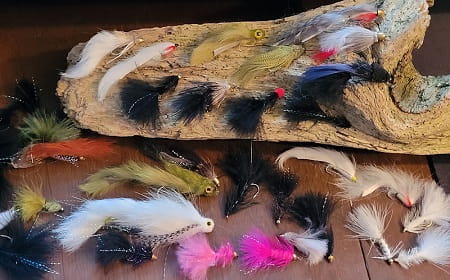
Most flies that work for winter steelhead will also work for summer steelhead.
Big bright flies can work at times, but most anglers use more subtle blacks, olives, or whites during the summer and colors when the salmon are in the river spawning or if the water is off-colored.
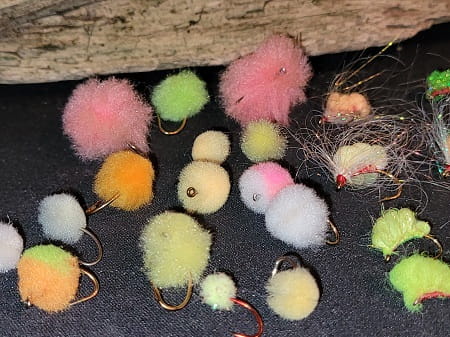
Eggs flies can also be one of the best options for steelhead, especially once they have made their way up the river.
If there are salmon in the river, don’t ignore egg fly patterns.
Some good summertime steelhead flies are:
- Caddisfly: both dry and nymph can work.
- Stonefly: Also known as the salmon fly, both dry fly and nymph are great options.
- Muddler Minnow: This could be used while nymphing but is usually used as a streamer or swinging fly.
- Brindle Bug: A traditional Spey-type fly
- Foam Floater: A beetle imitation.
- Greasy Fox: A traditional Spey type pattern in blue and black which are known hot colors for steelhead.
- Pom Skater: A skating-style dry fly for steelhead
- Intruder: Modern large spey flies designed by local West Coast steelhead anglers
- Hobo Spey: A large and easy-to-tie Spey fly designed and used on West Coast anglers, and it works great around the Great Lakes region.
- Egg Pattern: It’s hard for the fish to resist a well-presented egg fly pattern even early in the season. This can be your hottest fly if there are spawning salmon near by.
For more great fly options, see Best Steelhead Flies.
Best Lures
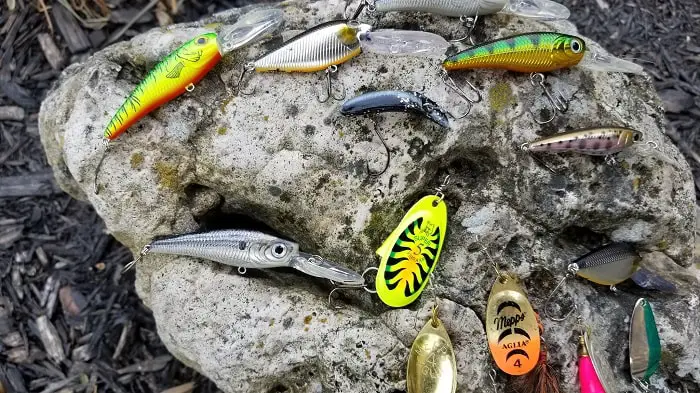
Blue Fox Vibrax – A relatively recent arrival on the spinner circuit, the Blue Fox in sizes 0 to 4 is now the most popular spinner in America.
For steelhead, you’ll want to use size 3 or 4 for greater casting distance and more active presentation in fast-moving water.
Mepps Aglia – Who didn’t grow up with Mepps spinners? They’ve worked for generations, bringing in huge steelhead across the USA, and the Aglia spinner remains one of the best spinners.
Rapala Tail Dance – When you think of Rapala, you’re usually after Northern Pike or Walleye, but the Tail Dance is an outstanding steelhead lure as well. It works in slower water and has better depth control than other artificial crankbaits. Under most conditions, a Rapala will help you land more fish.
Little Cleo Spoon – There is something magic about a spoon. It doesn’t look like much hanging on the line, but in the water, it can get strikes when nothing else works. The Little Cleo is a proven steelhead spoon.
Kwikfish and Flatfish: Basically the same, these wobbling plugs are hard for steelhead to resist. I prefer them in slower pools or when the fish are less active due to cold weather. It is also my best lure when fishing at night. Be sure to follow regulations in California, Oregon, and other states to be sure night fishing is allowed.
Aerojig Twitching Jig – Jig fishing is an art. The movement of the rod, reel, and the angler’s action on the jig are often considered the ultimate fishing skill. An Aerojig with a correctly matched rubber minnow is a fabulous lure.
Spinner Fishing
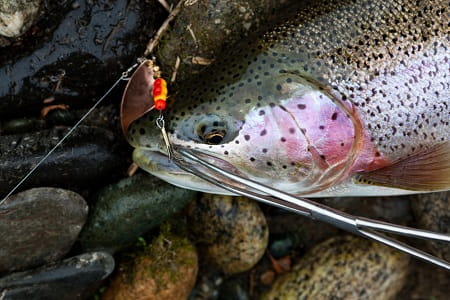
Summer steelhead love to hit spinners if presented well.
Some spinners, like the Blue Fox Vibrax and the Panther Martin, create sonic vibrations in the water, enhancing the light-gathering aspects of the lures.
Jig Fishing
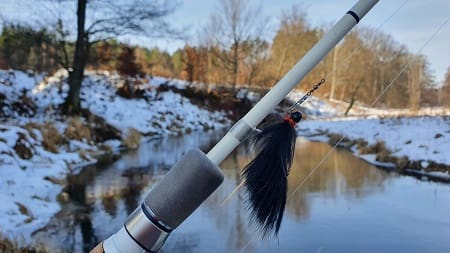
Jigs are not something most anglers would think to use for summer steelhead, but jigs work very well. Anglers will drift jigs under float or use a method known as Twitching Jigs.
For more on this effective steelhead method and the best steelhead jigs, check out Jig Fishing For Steelhead.
Best Baits
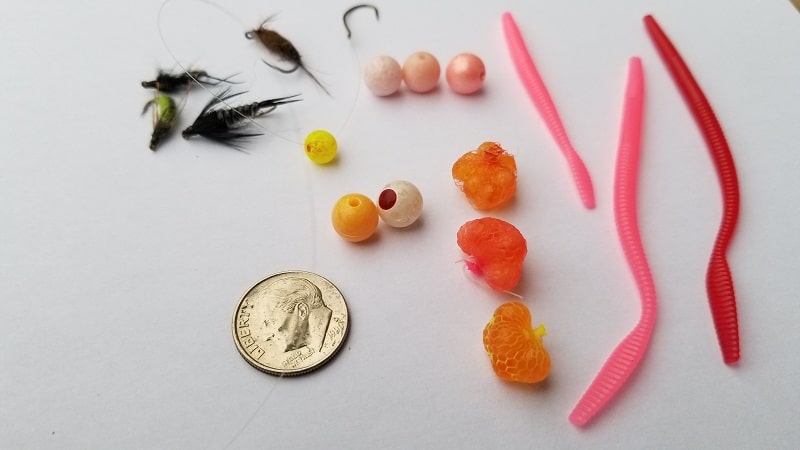
There is a number of good baits for summer steelhead. Worms, beads or cured chinook salmon roe can be the best baits you can offer at times.
Plastic worms, shrimp, skein, minnows, and even Powerbait can be good.
See 11 Best Baits For Steelhead.
Bead Fishing
When the spawn is in full bloom, whether chinook, coho salmon or steelhead, it’s time for beads. Beads resemble natural fish eggs and steelhead love loose eggs.
There are four standard sizes of beads. If the chinook salmon spawn is on, use larger 8mm beads since they are about the size of a salmon egg.
At other times, the smaller size beads work well. Selected a color, mottled blood is often best, and hook with a size 8 to 12 hook and get it in the water.
Is the Summer-run Steelhead Endangered?
Summer run Steelhead are becoming endangered in some areas and according to some fishery departments, and are considered a fishery at risk. You can protect them by releasing them unharmed, or simply leaving them alone and focusing on the winter steelhead which in most areas is a more stable fishery.
If you have a question, comment, advice, or tips about catching steelhead in the summer, let us know in the comments section below.
Tight Lines,
Graham
